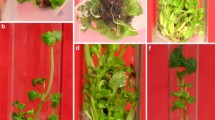Abstract
A method to produce encapsulatable units for synthetic seeds was developed in Asparagus officinalis L. Encapsulatable units with high conversion ability in non-sterile soil were produced from somatic embryos by a pre-encapsulation culture. The synthetic seeds containing somatic embryos without the pre-encapsulation culture did not germinate in soil. When the pre-encapsulation culture medium did not contain growth regulators, the roots elongated too much to accomplish encapsulation. Several growth regulators were studied and indole-3-acetic acid was considered to be optimum at 28.5 μM. The pre-encapsulation culture medium with indole-3-acetic acid inhibited the growth of roots during the pre-encapsulation culture and produced compact encapsulatable units. The growth of roots was promoted when plants were produced from the encapsulatable units. The percent conversion of the synthetic seeds with these encapsulatable units was 72% in non-sterile soil. This is the first report on synthetic seeds in Asparagus officinalis L.
Similar content being viewed by others
References
Conner AJ, Abernethy DJ & Falloon PG (1992) Importance of in vitro storage root development for the successful transfer of micropropagated asparagus plants to greenhouse conditions. NZ. J. Crop Hort. Sci. 20: 477–481
Delbreil B, Goebel–Tourand I, Lefrançois C & Jullien M (1994) Isolation and characterization of long–term embryogenic lines in Asparagus officinalis L. J. Plant Physiol. 144: 194–200
Esau K (1898) Anatomy of seed plants. John Wiley & Sons, Inc., Republic of Singapore
Ghosh B & Sen S (1994) Plant regeneration from alginate encapsulated somatic embryos of Asparagus cooperi baker. Plant Cell Rep. 13: 381–385
Goldberg R, Guillou L, Prat R, Dubacq JP & Roland JC (1992) Structure and biochemistry of endosperm breakdown in Asparagus officinalis seedlings. Plant Physiol. Biochem. 30: 477–485
Levi A & Sink KC (1991) Histology and morphology of asparagus somatic embryos. HortScience 26: 1322–1324
Li B & Wolyn DJ (1995) The effects of ancymidol, abscisic acid, uniconazole and pacrobutrazol on somatic embryogenesis of asparagus. Plant Cell Rep. 14: 529–533
Mamiya K & Sakamoto Y (2000) Effects of sugar concentration and strength of basal medium on conversion of somatic embryos in Asparagus officinalis L. Sci. Hortic. 84: 15–26
Murashige T & Skoog F (1962) A revised medium for rapid growth and bioassays with tobacco tissue cultures. Physiol. Plant. 15: 473–497
Onishi N, Mashiko T & Okamoto A (1992)Cultural system producing encapsulatable units of synthetic seeds in celery. Acta Hortic. 319: 113–118
Onishi N, Sakamoto Y & Hirosawa T (1994) Synthetic seeds as an application of mass production of somatic embryos. Plant Cell Tiss. Org. Cult. 39: 137–145
Redenbaugh K, Paasch BD, Nichol JW, Kossler ME, Viss PR & Walker KA (1986) Somatic seeds: encapsulation of asexual plant embryos. Bio/technology 4: 797–801
Reuther G (1984) Asparagus. In: Sharp WR, Evans DA, Ammirato PV & Yamada Y (eds) Handbook of Plant Cell Culture, Vol. 2 (pp 211–242). Macmillan Publishing Co., New York
Sakamoto Y, Mashiko T, Suzuki A, Kawata H & Iwasaki A (1992) Development of encapsulation technology for synthetic seeds. Acta Hortic. 319: 71–76
Sakamoto Y, Umeda S & Ogishima H (1991) Artificial seed comprising a sustained–release sugar granule. United States Patent 5,010,865
Sanada M, Sakamoto Y, Hayashi M, Mashiko T, Okamoto A & Ohnishi N (1993) Celery and lettuce. In: Redenbaugh K (ed) Synseeds: Applications of Synthetic Seeds to Crop Improvement (pp 305–327). CRC Press Inc., Boca Raton, FL, USA
Author information
Authors and Affiliations
Rights and permissions
About this article
Cite this article
Mamiya, K., Sakamoto, Y. A method to produce encapsulatable units for synthetic seeds in Asparagus officinalis. Plant Cell, Tissue and Organ Culture 64, 27–32 (2001). https://doi.org/10.1023/A:1010620313812
Issue Date:
DOI: https://doi.org/10.1023/A:1010620313812




